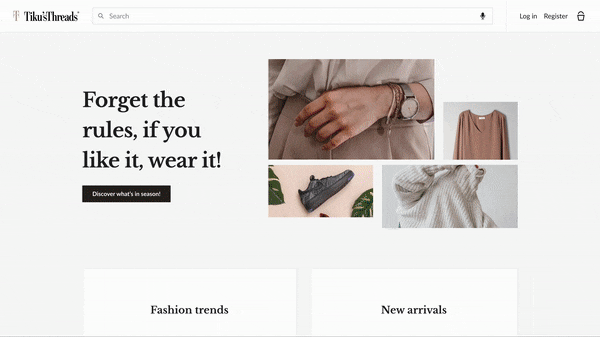Imagine a shopper walks into your retail store and approaches an associate on the floor. “I’m going outdoor rock climbing for the first time next month,” the shopper says. “What kinds of products should I buy?”
The associate blinks a few times. Despite your store’s highly relevant inventory — from harnesses to helmets and much more — he replies, “I couldn’t find any results for your query. Why don’t you try one of these popular categories instead? Golf clubs? Baseballs?”
While this experience wouldn’t happen in your brick-and-mortar store, it’s common with online search. Luckily, it doesn’t have to be.
Enter: Constructor’s AI Shopping Assistant
As Generative AI transforms the business landscape, ecommerce companies are tapping into its potential to improve online and mobile shopping experiences and further monetize conversational commerce.
In cases like the one above, when shoppers have identified a need — but don’t know exactly what item(s) will fulfill it — it often helps to speak with an expert. In physical stores, that expert is a trusted associate, who’ll highlight the most appropriate products, like rock climbing gear, supplies, and apparel. In an ecommerce environment, an AI Shopping Assistant plays that role.
Used by ecommerce companies around the world, Constructor’s AI Shopping Assistant (ASA) is a conversational product search and discovery tool that blends Generative AI with Constructor’s user-level personalization to optimize for ecommerce KPIs. With ASA, shoppers can pose detailed questions or engage in conversations to receive recommendations tailored to their unique preferences, shopping history, and intent — all reflective of your real-time inventory.
The end result is that ecommerce businesses increase retention rates, as shoppers stay on-site to research. And shoppers have an easier, more enjoyable product discovery journey. This increased website “stickiness,” brand loyalty, and engagement is a win-win for all. (And as you’ll see, even outside of product search, ASA can also improve on-site engagement.)
Not Your Typical Chatbot
ASA goes beyond the typical chatbot, which many companies are familiar with. In fact, 71% of companies have invested in offering a chatbot.
But traditional chatbots have limitations. They often require ecommerce companies to configure complex “if-then” logic and only address frequently asked questions with canned responses, before passing more complex queries to a human agent. This is all while shoppers twiddle their thumbs.
This inhibits adoption. Among users who avoid chatbots, 1 in 5 (20%) say it’s because “chatbots don’t often understand what I need.”
Thanks to Generative AI paired with the use of large language models (LLMs) and transformers, ASA understands shoppers in a way that was never possible before. Tailor-made for ecommerce, it’s able to instantaneously interpret and respond to a wide range of queries with meaningful and individualized suggestions, spanning both product and content items. This user-level personalization results in a much better product discovery experience for customers of sites with large catalogs.

AI Shopping Assistant: The Look and Feel in Search
ASA is flexible and customizable. We can implement it in a way that’s consistent with your branding, using lingo and functionality that resonate with your customers.
Some companies integrate ASA functionality into their online search through a pop-up, with options to search intelligently. Others opt for an AI toggle on their search bar or simply generate AI-powered suggestions directly within existing on-site search and search results. (Since shoppers intuitively know where to find the search bar, offering the AI toggle could increase engagement even more. This is shown in the product video in the following section.)
As for the types of queries and tasks that ASA can address, here are some examples for inspiration, many of which are already in use today. As you’ll see in examples 4 and 5, there are valuable and practical use cases outside of search, too.
1. Search Modes / Intent-Based Recommendations
When shoppers have a complex need and aren’t sure how to address it, ASA can act as a personal shopping assistant.
Various search modes and queries generate intent-based recommendations, including:
- Complete the Look. E.g., “What goes with this jean jacket?” ASA automatically generates in-stock suggestions across categories (pants, shirts, shoes, etc.) that’ll complement the jacket and reflect the shopper’s preferred styles, colors, price points, etc. based on clickstream, or first-party behavioral data.
- Style Assistant. E.g., “I’m attending a wedding in the Caribbean in August. What can I wear in the summer heat?” Again, ASA recommendations are easy to navigate, make sense contextually, are personalized, and span various in-stock products and categories (dresses, shoes, hats, etc.) to promote bundling.
- Recipe. E.g., “What’s a good dessert I can make for someone who likes blueberries and is gluten-free?” or “Gluten-free blueberry muffin recipe.” In addition to generating recipes with items the grocer has available, ASA makes personalized recommendations for each ingredient. (So, if the recipe calls for milk, and the shopper tends to buy organic, then options for organic milk are shown.) Customers can easily add every product to cart from the recipe page.
- List. E.g., “Blush, eyeshadow, mascara” or “Kibble, chew toy, collar.” In the first example, makeup recommendations map to the shopper’s preferred brands, colors, and palettes. In the second, ASA infers meaning based on other items listed and the shopper’s history to return dog collars (not cat collars) among the other recommended items.
- Suggestion. E.g., “What are good school supplies for a ninth-grader?” or “I’m going camping with my pre-teens for the first time in the White Mountains. What do we need?” or “What do I need to mount a 60-inch TV to my wall?” Suggestions highlight relevant products across categories. Recommendations are often based not only on product data and shopper affinities, but also on on-site content. In the last example, DIY wall-mounting guides can also be displayed to the shopper, alongside product suggestions.

2. Zero Results: Follow-Up and Suggestions
AI Shopping Assistant also provides an even smarter way to handle “zero-result” searches. Let’s say a shopper searches for “men’s paisley shirts” on your apparel site, but you don’t carry attractive choices. Interpreting the shopper’s request and analyzing their history (all in a split-second), the AI engine could respond with something like: “We don’t currently carry men’s paisley shirts. But we do have other big prints that might catch your eye. Check out our floral and vintage patterns and new arrivals in men’s casual shirts.”
ASA generates recommendations dynamically, eliminating the need for manual merchandising.
3. Intent-Based Suggestions (Autocomplete)
When shoppers start typing in your search bar, you can amp up the utility and impact of autocomplete functionality with ASA intent-based suggestions.
Let’s say someone is searching for office clothes. ASA could suggest search terms including “office clothes for summer,” “office clothes for women – business casual,” “office clothes comfort fit,” and so on.
These suggestions likely wouldn’t appear in traditional autocomplete, as your product catalog data may not be complete. But when suggesting the “office clothes comfort fit” query, ASA infers beyond product catalog details. The Generative AI-powered tool recognizes the material in product images, content from reviews, and more to populate suggestions.
Then, when shoppers select a suggested search query, the results shown are personalized to them.

Now, let’s explore a few ASA uses outside of search.
4. Intent-Based Collections
ASA creates powerful, engaging experiences even outside of the search bar.
Using ASA for intent-based collections, ecommerce companies can automatically generate landing pages to engage their shoppers, such as “Holiday Gift Ideas,” “Office-Ready Styles,” “Makeup 101 Essentials,” “The Best Jeans for Fall,” and so on. ASA not only instantly curates collections based on KPIs (no manual rule creation involved), it also personalizes the products shown on a user-level.
Importantly, ASA improves the completeness of collections, thanks to its ability to read images and automatically interpret whether a product belongs in a particular group. Even when ecommerce companies’ product catalog data is mislabeled or missing, items won’t get overlooked. ASA’s Generative AI recognizes an image is denim and belongs in the jeans collection, even if it was tagged incorrectly internally.
Ecommerce companies can consider highlighting these collections to shoppers on their homepage and category pages, displaying them to shoppers who fall into certain demographics or exhibit certain behaviors, showcasing them in triggered emails, and more.

5. Text-Based Recommendations
Your ecommerce site likely has helpful content resources, including guides and blog posts meant to engage your shoppers.
Let’s say you’re a grocer and have a blog post on “Why Eating Superfoods For Breakfast Kick Starts Your Day.” There’s no need to manually select product recommendations to insert in the post. ASA is capable of reading your content and selecting food images and recommendations to complement the text, like chia seed yogurt, quinoa porridge, acai berry bowl, etc.
Also, images are dynamically generated and tailored to the reader. So, someone whose history shows they don’t purchase berries might see avocado toast instead.

See ASA in Action
AI Shopping Assistant is already in use with ecommerce companies across industries, including leading grocery chains, apparel brands, and general retailers. They’re expanding the ways ASA can serve them and their customers to improve engagement, loyalty, and time on site.
Just like the rest of Constructor’s suite of holistic product search and discovery solutions, ASA feeds data into the Native Commerce Core™, which learns from every user query and interaction, hundreds of millions of times per day. This constant feedback loop ensures our platform delivers the best, most attractive experiences across all facets of the digital shopper journey.
And ASA is making waves in the broader industry as well, as ecommerce companies seek to effectively apply Generative AI. At NRF 2024, we showed the solution in our booth and from our partner Amazon Web Service’s (AWS’) booth as well. ASA was also named among “The Best of NRF,” and Retail Times notes how, with ASA, ecommerce companies can “better meet shoppers on the pathway to purchase and build brand affinity and loyalty.”
Ready to learn more? See how AI-native solutions like ASA can help your business grow.

